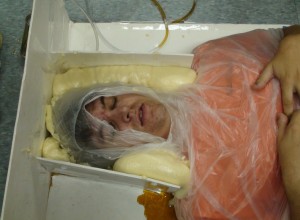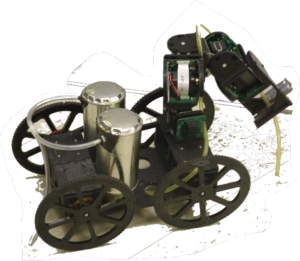Victim manipulation has been generally avoided by the robotics community for good reason. Improper manipulation can often result in further injury to or death of the victim. As a rule of thumb, any situation in which both a human or a robot can rescue a victim, a human rescuer is usually the better option. However, there are a variety of situations in which only a robot can effect a rescue. These situations are typically characterized by difficult to access locations, or by the need for rapid deployment.
Automatically Deployed Harness
An automatically deployed harness is a device that can be attached to a victim that can enable safe transport of the victim. Ideally this device would be something like a basket stretcher in which the victim is safely strapped with head/neck stabilization. Slightly less ideal, but still valid solutions focus on two components, 1) attaching a device to the victim in a manner that can bear the weight of the victim without injuring him or her, and 2) protecting the head/stabilizing the neck.
The loadbearing aspect of the harness has an impact on the style of transport. A harness surrounding the center of gravity of the victim would allow better manipulation for the placement on to a basket etc. A loadbearing aspect which focuses on the wrists or ankles may be better suited for dragging a victim or transport through a small hole from a confined space as the cross-sectional area of the victim is minimized. Wristlets are a device currently available to first responders for this type of extraction, though they are typically used on conscious victims. While shown on the wrists, these can also easily be used as anklets, looped on the ankles.
Head/neck Stabilization

Cervical spine immobilization is standard practice in rescue operations with inactive patients. The neck is immobilized until it can be confirmed that there is no neck injury. Immobilization involves holding
the head at a “neutral position” limiting the three rotational degrees of freedom (flexion/extension, rotation and bending). The neutral position is somewhat ill-defined~\cite{spineguidelines}, but is roughly where the head is looking forward. Typically, immobilization involves some form of collar.
To stabilize the neck we developed a novel solution using a two-part expandable poly-urethane foam. The selection of foam agent is important. There are some foams commonly available for filling cement cracks,
or for home improvement type applications. In general these foams do not work well. The ideal foam
has a large expansion ratio, is very stiff, hardens quickly (less than 2 minutes), and generates little heat and fumes. We have identified such a foam through an OEM polymer manufacturer.
An Early Mobile Robot Prototype

We use CKBot modules to build a mobile robot with an arm. It has 4 “wheel modules” and 7 joint modules which form an arm with a gripper on the end. The robot uses differential steering (or tank drive) to maneuver on the terrain (flat carpet in this case).
One of the primary limitations of small robots is the force that it can apply to the environment. The robot generates 20N of pulling force on flat carpet. While capable of applying the forces required for moving ams it can has trouble moving legs. Values in Table~?? are highlighted in {\bf bold face} to indicate which operations the robot can accomplish.
In the field, it would be desirable to have a robot that could apply forces greater than the 90th percentile
with some factor of safety and over arbitrary terrain. For example, if we focus on arm manipulation, a pulling strength of 45N would be able to handle all arm tasks and many leg tasks as well. A robot capable of handling 202N would be able to handle all tasks we’ve identified with a factor of safety of 2.
Wristlet Human Manipulation
It is difficult for small robots to pull a backboard or skiff so, we propose using a robot mountable
wristlet. Ratcheted grippers much like handcuffs which are used to grab the victims wrists or ankles. The grippers close automatically and latch closed – also like real handcuffs. However, the gripping surface is larger than handcuffs and much less likely to cut or injure the victim when pulling on them.
In the event only one arm or leg is accessible, a wristlet could be applied and used with a tether to either expose another arm or leg, or if life threatening, could still be used to drag a body to safety. In the event that neither arms nor legs are accessible (though none of the 180 simulated trials showed this case), this approach would not work.
Related Papers:
-
![[DOI]](https://www.modlabupenn.org/wp-content/plugins/papercite/img/external.png) M. Yim, T. Cragg, and S. -K. Hayat, “Towards small robot aided victim manipulation,” in Safety, security rescue robotics (ssrr), 2009 ieee international workshop on, 2009, pp. 1-6.
M. Yim, T. Cragg, and S. -K. Hayat, “Towards small robot aided victim manipulation,” in Safety, security rescue robotics (ssrr), 2009 ieee international workshop on, 2009, pp. 1-6.
[Bibtex]@INPROCEEDINGS{MY:TC:SH:09, author={Yim, M. and Cragg, T. and Hayat, S.-K.}, booktitle={Safety, Security Rescue Robotics (SSRR), 2009 IEEE International Workshop on}, title={Towards small robot aided victim manipulation}, year={2009}, pages={1-6}, keywords={emergency services;health care;human-robot interaction;medical robotics;mobile robots;cervical spine immobilization;human limb manipulation;human victims;incapacitated victim transportation;limb pose forces;limb pose statistics;man portable robots;robot aided victim manipulation;wristlet mechanism;Data analysis;Gases;Humans;Injuries;Motion analysis;Personnel;Protection;Robot kinematics;Robotics and automation;Statistical analysis;automated harness;c-spine;rescue;victim manipulation}, doi={10.1109/SSRR.2009.5424147},}